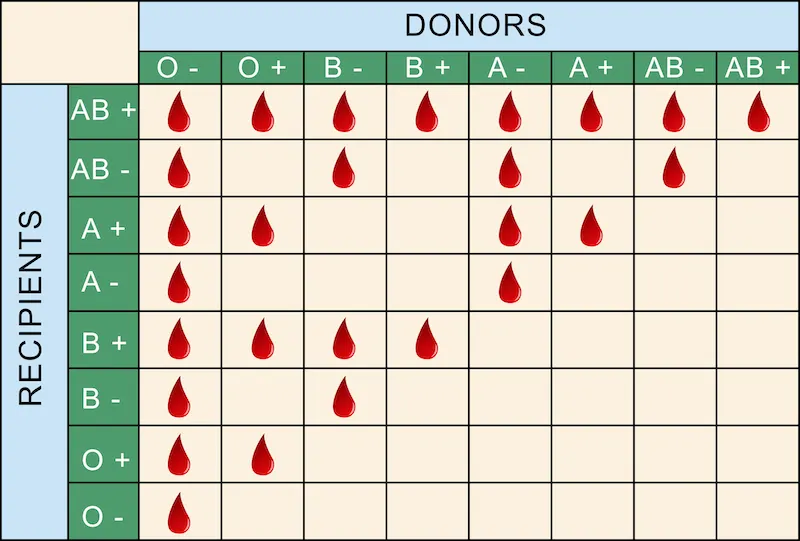Throughout your donor search, you may contemplate the significance of your donor's blood type and how it will affect your future offspring. While choosing a sperm donor based on their blood type is not typically considered a crucial factor in the decision-making process, individuals and couples often have certain criteria in mind. Keep in mind, however, that blood type compatibility is generally not a significant concern unless a specific medical condition or genetic disorder requires consideration.
How Is Blood Type Determined?
The presence or absence of certain antigens on the surface of red blood cells determines blood type. The most common blood types are A, B, AB, and O, each with positive or negative Rh factors. Regarding fertility and conception, blood type compatibility does not play a significant role.
However, there are certain situations where blood type compatibility may be considered. For example, if the intended parent has Rh-negative blood and the sperm donor has Rh-positive blood, it could potentially lead to Rh incompatibility issues during pregnancy. In such cases, medical interventions like Rh immunoglobulin shots can be administered to prevent complications.
While blood type compatibility can be a consideration in certain circumstances, it is not typically a primary factor when choosing a sperm donor. Other factors such as health history, genetic screening results, physical characteristics, and personal preferences are more important in the decision-making process. It is advisable to consult with your fertility specialist or sperm bank for personalized guidance based on individual circumstances.
What Blood Type Will My Child Have?
To predict your child's blood type, you need to understand the basic principles of genetics and blood type inheritance. The ABO blood group system is determined by the presence or absence of antigens A and B on the surface of red blood cells. These antigens are predictably inherited from parents.
Here are the steps to predict your child's blood type:
1. Determine your blood type: You can find your blood type by asking your doctor or getting a blood test.
2. Determine the blood type of your selected sperm donor: Cryobank America documents the blood type of each sperm donor, which can be found on their donor profiles.
3. Understand the ABO blood group system. The ABO system has four main blood types:
- A, B, AB, and O. Each person has two alleles (gene variants) for this system, one inherited from each parent.
- Allele A produces antigen A in red blood cells.
- Allele B produces antigen B in red blood cells.
- Allele O does not produce any antigens.
4. Determine the possible combinations: Based on your and your selected donor's blood type, you can determine the possible combinations of alleles that can pass on to your future child:
- If both parents have type A blood (AA or AO), their child can have either type A (AA) or type O (AO).
- If both parents have type B blood (BB or BO), their child can have either type B (BB) or type O (BO).
- If one parent has type A and the other has type B (AO and BO), their child can have either type A (AA), type B (BB), AB (AB), or O (AO/BO).
- If one parent has type AB and the other has any other blood type, their child can have either type A (AA), type B (BB), or AB (AB).
- If one parent has type O and the other has any other blood type, their child can have any blood type (A, B, AB, or O).

5. Consider the Rh factor: Rh is another antigen present in red blood cells. It is either positive (+) or negative (-). If both parents are Rh positive, their child will also be Rh positive. If one parent is Rh positive and the other is Rh negative, there is a chance the child could be Rh positive or negative.
It's important to note that these predictions are based on probabilities, and there can be exceptions due to rare genetic variations. To get an accurate prediction, it's best to consult a medical professional or genetic counselor who can consider additional factors and perform specific tests if necessary.
Blood Type Calculator
Select the blood type for you and your chosen sperm donor to determine your future child's potential blood type.
What Are The Rarest Blood Types?
The rarest blood types, along with their approximate percentage in the population, are as follows:
1. AB- (AB negative): Approximately 0.6% of the population.
2. B- (B negative): Approximately 1.5% of the population.
3. AB+ (AB positive): Approximately 3.4% of the population.
4. A- (A negative): Approximately 6.3% of the population.
5. O- (O negative): Approximately 6.6% of the population.
These percentages can vary slightly depending on geographical location and ethnic background, as blood type distribution can differ among populations.
What Are The Most Common Blood Types?
The five most common blood types in the USA, along with their approximate percentage of the population, are as follows:
1. O positive (O+): Approximately 38% of the population.
2. A positive (A+): Approximately 34% of the population.
3. B positive (B+): Approximately 9% of the population.
It's important to note that these percentages are approximate and can vary slightly depending on different sources and studies.
- Protecting Your Health: Choosing A Sperm Bank Over Natural Insemination
- Hatching a Plan: Learning The Basics About Assisted Hatching in IVF
- Navigating GYN Surgery Before Artificial Insemination
- PGT Testing and Its Role in IVF Treatment
- The Ultimate Guide To Where You Can Donate Sperm In All 50 States


